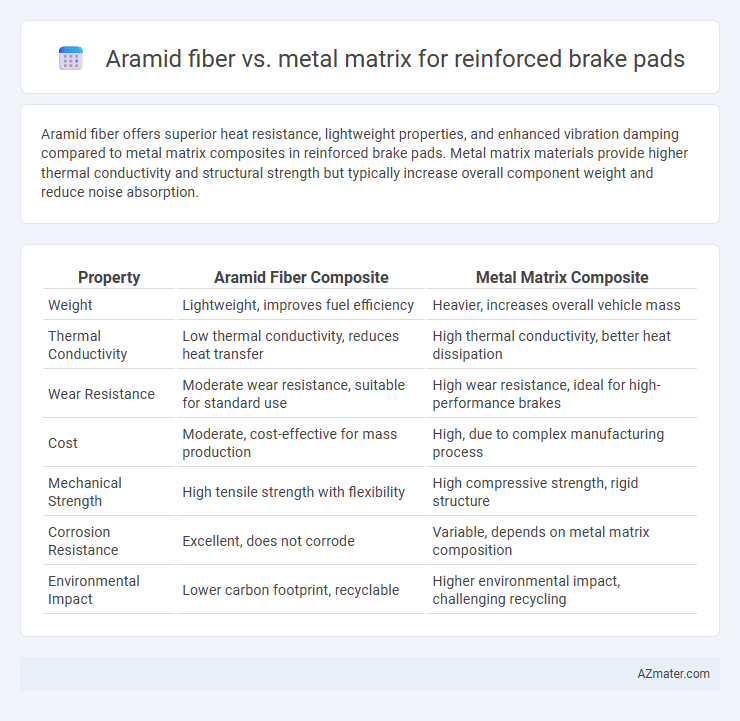Aramid fiber offers superior heat resistance, lightweight properties, and enhanced vibration damping compared to metal matrix composites in reinforced brake pads. Metal matrix materials provide higher thermal conductivity and structural strength but typically increase overall component weight and reduce noise absorption.
Table of Comparison
| Property | Aramid Fiber Composite | Metal Matrix Composite |
|---|---|---|
| Weight | Lightweight, improves fuel efficiency | Heavier, increases overall vehicle mass |
| Thermal Conductivity | Low thermal conductivity, reduces heat transfer | High thermal conductivity, better heat dissipation |
| Wear Resistance | Moderate wear resistance, suitable for standard use | High wear resistance, ideal for high-performance brakes |
| Cost | Moderate, cost-effective for mass production | High, due to complex manufacturing process |
| Mechanical Strength | High tensile strength with flexibility | High compressive strength, rigid structure |
| Corrosion Resistance | Excellent, does not corrode | Variable, depends on metal matrix composition |
| Environmental Impact | Lower carbon footprint, recyclable | Higher environmental impact, challenging recycling |
Introduction to Reinforced Brake Pads
Reinforced brake pads utilize advanced materials like aramid fiber and metal matrix composites to enhance performance and durability under high friction and temperature conditions. Aramid fiber offers exceptional tensile strength, thermal stability, and lightweight properties, improving wear resistance and noise reduction in brake pads. Metal matrix composites provide superior heat dissipation, mechanical strength, and structural integrity, making them ideal for high-performance braking systems exposed to extreme stress.
Overview of Aramid Fiber and Metal Matrix Materials
Aramid fiber, known for its exceptional strength-to-weight ratio and thermal stability, is widely used in reinforced brake pads to enhance durability and resistance to high temperatures. Metal matrix materials, typically aluminum or iron-based composites, provide superior heat dissipation and mechanical strength, improving the brake pad's performance under intense friction conditions. Combining aramid fibers with metal matrices results in brake pads that balance lightweight properties with enhanced thermal conductivity and structural integrity.
Key Properties of Aramid Fiber Reinforced Brake Pads
Aramid fiber reinforced brake pads exhibit exceptional heat resistance, maintaining structural integrity at temperatures exceeding 500degC, which enhances braking performance and durability. Their high tensile strength and low density provide superior wear resistance and reduced pad weight compared to metal matrix composites, resulting in improved fuel efficiency and handling. Additionally, aramid fibers contribute to lower noise and vibration levels during braking, offering a smoother and quieter driving experience.
Key Properties of Metal Matrix Reinforced Brake Pads
Metal matrix reinforced brake pads exhibit superior thermal conductivity and enhanced structural strength, allowing for efficient heat dissipation and increased durability under high-stress braking conditions. Their high melting point and resistance to thermal deformation ensure consistent performance in extreme temperatures compared to aramid fiber composites. The metal matrix provides improved wear resistance and better load-bearing capacity, making it ideal for heavy-duty and high-performance braking applications.
Performance Comparison: Friction and Wear Resistance
Aramid fiber reinforced brake pads exhibit superior friction stability and lower wear rates compared to metal matrix reinforced pads, enhancing overall braking performance and longevity. The high tensile strength and heat resistance of aramid fibers contribute to consistent friction coefficients under varying temperatures, unlike metal matrices which may experience thermal softening. Aramid composites also reduce pad wear and rotor abrasion, leading to improved durability and efficiency in high-performance braking systems.
Thermal Conductivity and Heat Management
Aramid fiber reinforced brake pads exhibit low thermal conductivity, effectively insulating the brake system and reducing heat transfer to surrounding components. Metal matrix composites, such as aluminum or copper-based reinforcements, offer higher thermal conductivity, enabling faster heat dissipation and improved thermal management during braking. Optimizing brake pad materials requires balancing aramid fiber's thermal insulation with metal matrix's heat conduction to prevent brake fade and maintain consistent performance.
Durability and Lifespan Considerations
Aramid fiber reinforced brake pads exhibit superior durability due to their high tensile strength and excellent heat resistance, resulting in longer lifespan under intense braking conditions. Metal matrix composites offer enhanced wear resistance and thermal conductivity, which improves heat dissipation and reduces brake fade, contributing to consistent performance over time. Choosing between aramid fiber and metal matrix materials depends on the specific application demands for thermal stability and mechanical stress endurance in brake systems.
Cost Analysis and Manufacturability
Aramid fiber brake pads offer a lower material cost and improved machinability compared to metal matrix composites, making them more cost-effective for large-scale production. Metal matrix reinforced pads exhibit higher initial material expenses and require advanced manufacturing processes like powder metallurgy, which increases production complexity and tooling costs. Evaluating total cost, aramid fiber composites provide better manufacturability and reduced lifecycle expenses, whereas metal matrix composites deliver superior structural strength at a premium price point.
Environmental Impact and Sustainability
Aramid fiber reinforced brake pads offer a lower environmental impact compared to metal matrix composites due to their lightweight nature, which reduces vehicle fuel consumption and associated emissions. Aramid fibers are also biodegradable and derived from non-metallic sources, enhancing sustainability by minimizing reliance on finite metal resources and decreasing pollution generated during manufacturing. Metal matrix brake pads, while durable, involve energy-intensive extraction and processing, contributing to higher carbon footprints and less sustainable end-of-life disposal options.
Conclusion: Choosing the Right Material for Brake Pads
Aramid fiber brake pads offer superior heat resistance, lightweight properties, and excellent friction stability, making them ideal for high-performance and everyday driving conditions. Metal matrix brake pads deliver exceptional wear resistance and high thermal conductivity, suited for heavy-duty applications requiring durability under extreme temperatures. Selecting the right material depends on balancing performance needs, thermal management, and operating environment to ensure optimal braking efficiency and longevity.

Infographic: Aramid fiber vs Metal matrix for Reinforced brake pad
 azmater.com
azmater.com